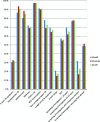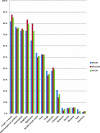A cross-sectional survey of the knowledge, attitudes and practices regarding tuberculosis among general practitioners working in municipalities with and without asylum centres in eastern Norway
- PMID: 30572893
- PMCID: PMC6302494
- DOI: 10.1186/s12913-018-3792-4
A cross-sectional survey of the knowledge, attitudes and practices regarding tuberculosis among general practitioners working in municipalities with and without asylum centres in eastern Norway
Abstract
Background: The number of tuberculosis (TB) cases in Norway is increasing due to immigration from countries with high TB prevalence and few studies have been conducted on general practitioners' (GPs) knowledge of TB in low incidence countries. The main purpose of this study was to explore knowledge, attitudes and practices of TB among Norwegian GPs using a modified Knowledge Attitude Practice (KAP) survey template.
Methods: A cross-sectional survey of 30 questions was distributed by email using SurveyMonkey to GPs working in municipalities either with or without an asylum reception centre in Eastern Norway (GPwAS or GPw/oAS). The questionnaire assessed demographic data and had 14 questions on TB knowledge and 7 questions on attitudes and practices. Descriptive and inferential analysis of the data was carried out using SPSS 18.
Results: One hundred ninety five GPs responded and 42% worked in a municipality with an asylum reception centre. There was no significant difference between the two GP groups in relation to demographic variables (all p-values > 0.2). GPwAS were more experienced in diagnosing TB patients compared to GPw/oAS (63.4% vs 44.2%, p = 0.008). There was no significant differences in participation in TB training between the two groups (8.5% vs 7.6%, p = 0.71). The majority of GPs (69%) did not consider TB as a major public health threat and misconceptions of TB epidemiology were identified. Overall, 97 (49.7%) GPs had good TB knowledge level and good TB knowledge level was associated with experience in diagnosing TB patients (p = 0.001) and recent TB training (p = 0.015).
Conclusion: Gaps in TB knowledge and awareness among GPs in Norway need to be addressed if GPs are to be more involved in TB management and prevention in the future. TB training had an effect on the GPs knowledge level and GPwAS had more experience with TB patients but our survey revealed no major differences in KAP between GPwAS and GPw/oAS.
Keywords: Knowledge, attitudes and practice (KAP); Norway; Physicians; Tuberculosis (TB).
Conflict of interest statement
Author’s information
Oddvar Aadnanes is a general practitioner from Norway who became more aware of the global TB challenge through his clinical experience in Mongolia and Uzbekistan.
Ethics approval and consent to participate
Ethical approval was received from the University of Liverpool. The Regional Committee for Medical Research Ethics of Southern Norway (REC) considered the study to be outside the remit of the Health Research Act and therefore the study could be implemented without approval of REC. Information about the study and informed consent was provided in writing before the participants were able to access the online survey questionnaire. Confidentiality and anonymity were maintained through the settings of the online survey.
Consent for publication
Not applicable.
Competing interests
The authors declare that they have no competing interests.
Publisher’s Note
Springer Nature remains neutral with regard to jurisdictional claims in published maps and institutional affiliations.
Figures
Similar articles
-
Valuation of knowledge, attitude, practices of tuberculosis among the health care workers from Islamabad Pakistan.Acta Trop. 2024 Sep;257:107317. doi: 10.1016/j.actatropica.2024.107317. Epub 2024 Jul 7. Acta Trop. 2024. PMID: 38981566
-
General practitioners' knowledge and practice in consultations with (potential) torture victims: a qualitative pilot study from Norway.Scand J Prim Health Care. 2024 Dec;42(4):723-737. doi: 10.1080/02813432.2024.2404054. Epub 2024 Sep 13. Scand J Prim Health Care. 2024. PMID: 39275802 Free PMC article.
-
How do private general practitioners manage tuberculosis cases? A survey in eight cities in Indonesia.BMC Res Notes. 2015 Oct 14;8:564. doi: 10.1186/s13104-015-1560-7. BMC Res Notes. 2015. PMID: 26468010 Free PMC article.
-
Knowledge, attitudes and practices of general medical practitioners in developed countries regarding oral cancer: an integrative review.Fam Pract. 2020 Oct 19;37(5):592-605. doi: 10.1093/fampra/cmaa026. Fam Pract. 2020. PMID: 32253436 Free PMC article. Review.
-
General Practitioners' Knowledge, Attitudes, and Practices of Dietary Advice for Weight Control in Their Overweight Patients: A Scoping Review.Nutrients. 2023 Jun 27;15(13):2920. doi: 10.3390/nu15132920. Nutrients. 2023. PMID: 37447247 Free PMC article.
Cited by
-
A questionnaire of knowledge, attitude and practices on tuberculosis among medical interns in Nepal.J Clin Tuberc Other Mycobact Dis. 2020 Jul 8;20:100173. doi: 10.1016/j.jctube.2020.100173. eCollection 2020 Aug. J Clin Tuberc Other Mycobact Dis. 2020. PMID: 32685706 Free PMC article.
-
Missed Opportunities in the Diagnosis of Tuberculosis Meningitis.Open Forum Infect Dis. 2023 Feb 1;10(2):ofad050. doi: 10.1093/ofid/ofad050. eCollection 2023 Feb. Open Forum Infect Dis. 2023. PMID: 36861091 Free PMC article.
-
Beyond the diagnosis of drug-resistant Tuberculosis in Norway: patients' experiences before, during and after treatment.BMC Public Health. 2024 Jul 6;24(1):1801. doi: 10.1186/s12889-024-19342-8. BMC Public Health. 2024. PMID: 38971760 Free PMC article.
-
Assessment of Knowledge, Attitudes, and Practices (KAP): Public Health and Economic Burden of Tuberculosis in Jarso District of West Wollega Zone, Oromia, Western Ethiopia.Biomed Res Int. 2022 Dec 8;2022:3314725. doi: 10.1155/2022/3314725. eCollection 2022. Biomed Res Int. 2022. PMID: 36531653 Free PMC article.
References
-
- World Health Organization. Global Tuberculosis Report 2017: World Health Organization; 2017. https://www.who.int/tb/publications/global_report/gtbr2017_main_text.pdf
-
- World Health Organization. The stop TB strategy: World Health Organization; 2006. http://apps.who.int/iris/bitstream/10665/69241/1/WHO_HTM_STB_2006.368_en...
-
- World Health Organization. The END TB strategy: World Health Organization; 2015. https://www.who.int/tb/strategy/End_TB_Strategy.pdf
-
- Norwegian Institute of Public Health. Tuberkulose i Norge 2015. Norwegian Institute of Public Health. 2015; https://www.fhi.no/publ/2016/tuberkulose-arsrapport-2015/.
Publication types
MeSH terms
LinkOut - more resources
Full Text Sources
Medical



